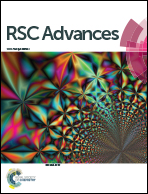Coumarin centered copper(ii) complex with appended-imidazole as cancer chemotherapeutic agents against lung cancer: molecular insight via DFT-based vibrational analysis†
Abstract
Coumarins are well known for the design of target-specific therapeutics for cancer oncology. In lieu of their potential applications as antitumor chemotherapeutics, a new coumarin-based copper(II) complex 1 was synthesized employing 6-methyl-3-((quinolin-8-ylimino)methyl)-3H-chromene-2,4-dione (L). The structure elucidation of 1 was done by various spectroscopic techniques (viz., IR, Raman, UV-vis, and EPR), elemental analysis and single crystal X-ray diffraction. Raman and IR combined with B3LYP/DFT frequency calculations were used to characterize the lattice dynamics with an emphasis on the doming mode vibrations of the copper site. Prominent features in the Raman and far-IR spectrum, indicative of doming modes, appeared in the 35–150 cm−1, other out-of-plane and in-plane mode of vibrations in the range of 160–250 cm−1 and 260–700 cm−1, respectively. Furthermore, preliminary in vitro binding studies of L and complex 1 with CT-DNA were carried out by various biophysical techniques. The results demonstrated that 1 avidly binds to CT DNA as compared to L and cisplatin (marketed drug in use for treating solid cancers) via a partial intercalative mode. Furthermore, pBR322 cleavage studies of 1 revealed the hydrolytically double-stranded cleavage pattern verified by T4 ligase religation. The cytotoxicity activity of L and complex 1 was carried out to evaluate cell growth inhibition in a human alveolar epithelial A549 cancer cells (human lung carcinoma) by the MTT assay. Interestingly, the IC50 value of complex 1 was found to be 4.6 ± 0.3 μM which is significantly lower as compared to the IC50 values of previously reported Cu(II) complexes. Furthermore, in the presence of 1, the level of reactive oxygen species (ROS) and thiobarbituric acid reactive substance (TBARS) displayed significant increase, coupled with reduced glutathione (GSH) levels on the A549 cancer cell. Thus, the results confirm the important role of ROS generation and discover Cu(II) complex 1 induced cell apoptosis and validate its potential to act as a robust anticancer drug entity.



 Please wait while we load your content...
Please wait while we load your content...